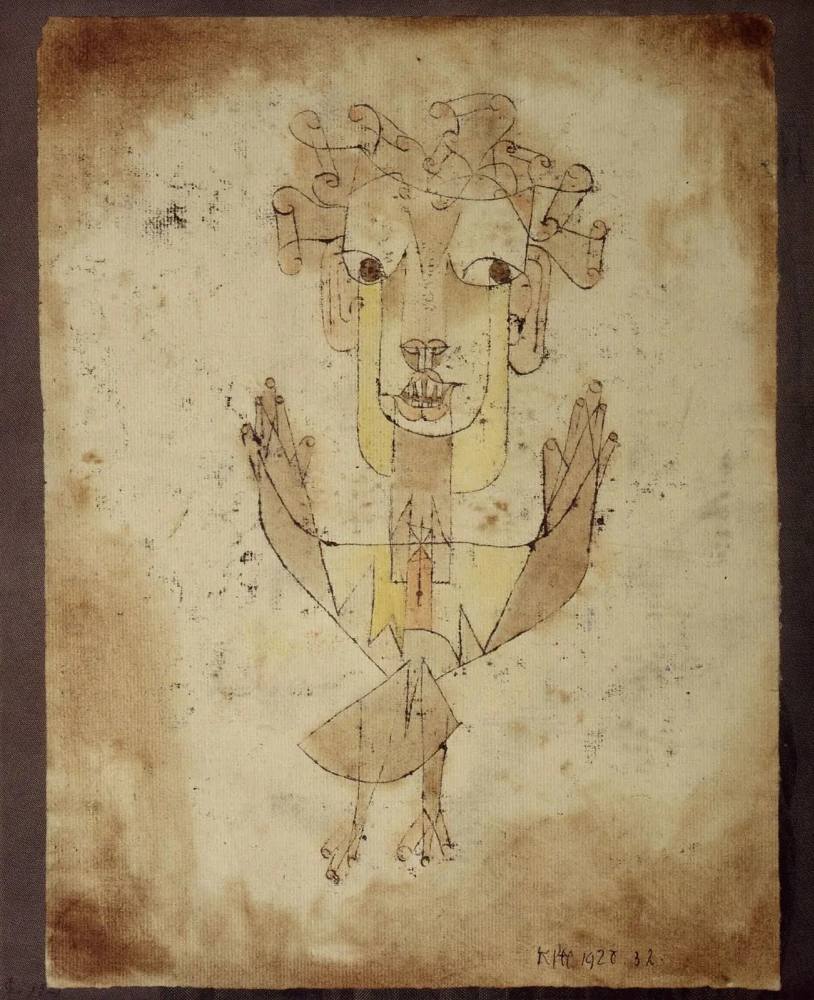log in
Enter site
Login to use Arthive functionality to the maximum
Nuevo angel (angelus novus)
Paul Klee • Pintura, 1920


















Descripción del cuadro «Nuevo angel (angelus novus)»
Es poco probable que Klee haya imaginado y formulado todos los significados con los que su pintura había crecido durante varias décadas. "Nuevo ángel" (angelus novus). Y casi ninguna de las pinturas de Klee recibió una retroalimentación filosófica y cultural tan profunda de varios de sus dueños a la vez. Todo esto es Klee: desde un punto en el lienzo, comienza a vivir un mundo entero, que ya no necesita orientación e imaginación, sino que vive por sí solo, de acuerdo con las leyes internas establecidas en él. Lo que sucedió después sería Paul Klee.
Se dice que Walter Benjamin, un judío y filósofo alemán, nunca se separó de esta acuarela, que compró al artista en 1921, inmediatamente después de la creación. Después de 12 años de contemplación diaria, escribirá sobre esta imagen la obra mística "Agesilaus Santander" y la mantendrá constantemente ante sus ojos como una forma clave de reflexión y un punto de referencia en su búsqueda espiritual. Este Benjamín llamará al ángel de garras ángel Klee el Ángel de la historia y en uno de sus libros principales describirá su movimiento a través de metáforas terribles y poderosas:“Klee tiene una foto llamada Angelus Novus. Representa a un ángel, mirando como si se estuviera preparando para desprenderse de algo, que está observando de cerca. Sus ojos están bien abiertos, su boca está redondeada y sus alas abiertas. Así es como debe verse el ángel de la historia. Su rostro se vuelve hacia el pasado. Donde para nosotros hay una cadena de eventos próximos, allí ve un desastre completo, constantemente agolpando las ruinas sobre las ruinas y tirándolo todo a sus pies. Se habría quedado para resucitar a los muertos y escombros ciegos. Pero el viento de ráfagas que sale del paraíso llena sus alas con tal fuerza que ya no puede plegarlas. El viento lo lleva incontrolablemente hacia el futuro, hacia el cual está de espaldas, mientras la montaña de escombros frente a él se eleva hacia el cielo. Lo que llamamos progreso es esta tormenta.
Después de que Walter Benjamin se suicidó en un pequeño hotel en 1940, fue rechazado para cruzar la frontera y perdió la esperanza de emigrar de la Francia ocupada por los fascistas, su Angelus Novus encontró otro hogar, pero aún no es famoso.
El nuevo propietario de la fotografía era el amigo de Benjamin Theodore Adorno, y luego su otro amigo, uno de los filósofos judíos más famosos, un investigador de Cabalá y un médico honorario de muchas universidades en el mundo, Gershom Schole. Hasta la muerte de Scholem en 1982, hasta 62 años después de su creación, casi nadie podía ver la imagen, pero se dio a conocer de antemano.
Y aunque algunos críticos y coleccionistas están furiosos por la fama inmerecida que se derrumbó en Angelus Novus (dicen, esta fama no se debe al mérito artístico de la imagen, sino a la ficción), la obra en el siglo XX vivió una vida de la que los artistas vanguardistas de los años 20 sinceramente soñado
Una vez, Angelus Novus salió a caminar y hasta el momento decidió elegir el Museo Nacional de Israel como su refugio.
Autor: Anna Sidelnikova
Se dice que Walter Benjamin, un judío y filósofo alemán, nunca se separó de esta acuarela, que compró al artista en 1921, inmediatamente después de la creación. Después de 12 años de contemplación diaria, escribirá sobre esta imagen la obra mística "Agesilaus Santander" y la mantendrá constantemente ante sus ojos como una forma clave de reflexión y un punto de referencia en su búsqueda espiritual. Este Benjamín llamará al ángel de garras ángel Klee el Ángel de la historia y en uno de sus libros principales describirá su movimiento a través de metáforas terribles y poderosas:“Klee tiene una foto llamada Angelus Novus. Representa a un ángel, mirando como si se estuviera preparando para desprenderse de algo, que está observando de cerca. Sus ojos están bien abiertos, su boca está redondeada y sus alas abiertas. Así es como debe verse el ángel de la historia. Su rostro se vuelve hacia el pasado. Donde para nosotros hay una cadena de eventos próximos, allí ve un desastre completo, constantemente agolpando las ruinas sobre las ruinas y tirándolo todo a sus pies. Se habría quedado para resucitar a los muertos y escombros ciegos. Pero el viento de ráfagas que sale del paraíso llena sus alas con tal fuerza que ya no puede plegarlas. El viento lo lleva incontrolablemente hacia el futuro, hacia el cual está de espaldas, mientras la montaña de escombros frente a él se eleva hacia el cielo. Lo que llamamos progreso es esta tormenta.
Después de que Walter Benjamin se suicidó en un pequeño hotel en 1940, fue rechazado para cruzar la frontera y perdió la esperanza de emigrar de la Francia ocupada por los fascistas, su Angelus Novus encontró otro hogar, pero aún no es famoso.
El nuevo propietario de la fotografía era el amigo de Benjamin Theodore Adorno, y luego su otro amigo, uno de los filósofos judíos más famosos, un investigador de Cabalá y un médico honorario de muchas universidades en el mundo, Gershom Schole. Hasta la muerte de Scholem en 1982, hasta 62 años después de su creación, casi nadie podía ver la imagen, pero se dio a conocer de antemano.
Y aunque algunos críticos y coleccionistas están furiosos por la fama inmerecida que se derrumbó en Angelus Novus (dicen, esta fama no se debe al mérito artístico de la imagen, sino a la ficción), la obra en el siglo XX vivió una vida de la que los artistas vanguardistas de los años 20 sinceramente soñado
Una vez, Angelus Novus salió a caminar y hasta el momento decidió elegir el Museo Nacional de Israel como su refugio.
Autor: Anna Sidelnikova


